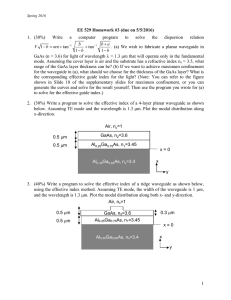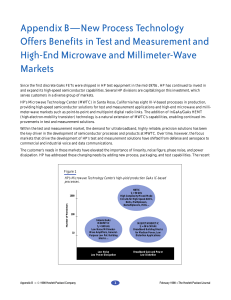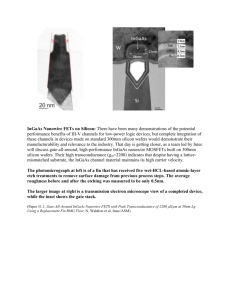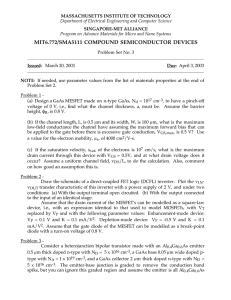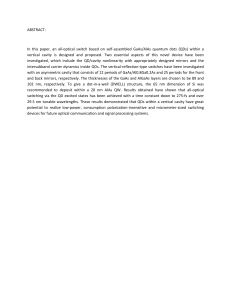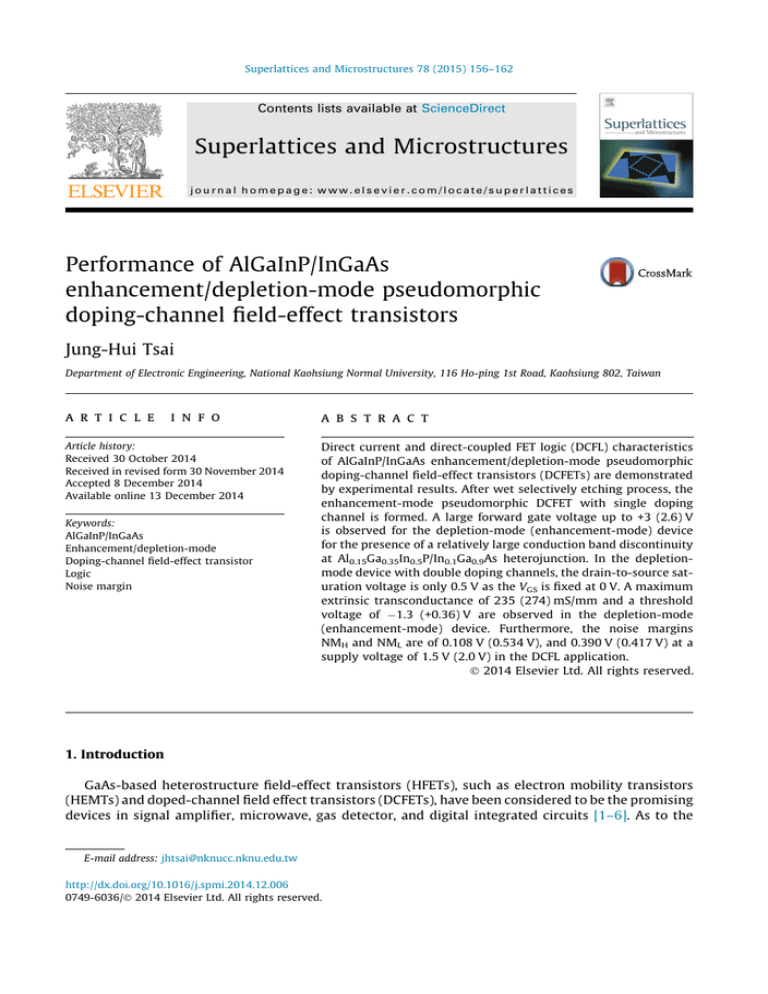
Superlattices and Microstructures 78 (2015) 156–162
Contents lists available at ScienceDirect
Superlattices and Microstructures
journal homepage: www.elsevier.com/locate/superlattices
Performance of AlGaInP/InGaAs
enhancement/depletion-mode pseudomorphic
doping-channel field-effect transistors
Jung-Hui Tsai
Department of Electronic Engineering, National Kaohsiung Normal University, 116 Ho-ping 1st Road, Kaohsiung 802, Taiwan
a r t i c l e
i n f o
Article history:
Received 30 October 2014
Received in revised form 30 November 2014
Accepted 8 December 2014
Available online 13 December 2014
Keywords:
AlGaInP/InGaAs
Enhancement/depletion-mode
Doping-channel field-effect transistor
Logic
Noise margin
a b s t r a c t
Direct current and direct-coupled FET logic (DCFL) characteristics
of AlGaInP/InGaAs enhancement/depletion-mode pseudomorphic
doping-channel field-effect transistors (DCFETs) are demonstrated
by experimental results. After wet selectively etching process, the
enhancement-mode pseudomorphic DCFET with single doping
channel is formed. A large forward gate voltage up to +3 (2.6) V
is observed for the depletion-mode (enhancement-mode) device
for the presence of a relatively large conduction band discontinuity
at Al0.15Ga0.35In0.5P/In0.1Ga0.9As heterojunction. In the depletionmode device with double doping channels, the drain-to-source saturation voltage is only 0.5 V as the VGS is fixed at 0 V. A maximum
extrinsic transconductance of 235 (274) mS/mm and a threshold
voltage of 1.3 (+0.36) V are observed in the depletion-mode
(enhancement-mode) device. Furthermore, the noise margins
NMH and NML are of 0.108 V (0.534 V), and 0.390 V (0.417 V) at a
supply voltage of 1.5 V (2.0 V) in the DCFL application.
Ó 2014 Elsevier Ltd. All rights reserved.
1. Introduction
GaAs-based heterostructure field-effect transistors (HFETs), such as electron mobility transistors
(HEMTs) and doped-channel field effect transistors (DCFETs), have been considered to be the promising
devices in signal amplifier, microwave, gas detector, and digital integrated circuits [1–6]. As to the
E-mail address: jhtsai@nknucc.nknu.edu.tw
http://dx.doi.org/10.1016/j.spmi.2014.12.006
0749-6036/Ó 2014 Elsevier Ltd. All rights reserved.
157
J.-H. Tsai / Superlattices and Microstructures 78 (2015) 156–162
S
Depletion Mode
D
300Å n+-GaAs
Enhancement Mode
S
D
G
200 Å i-Al0.15Ga0.35In0.5P
100Å n+-In0.1Ga0.9As
G
100 Å i-Al0.15Ga0.35In0.5P
100 Å i-Al0.15Ga0.35In0.5P
+
100Å n+-In0.1Ga0.9As
100Å n -In0.1Ga0.9As
300 Å i-Al0.15Ga0.35In0.5P
300 Å i- Al0.15Ga0.35In0.5P
5000 Å i-GaAs Buffer
S.I. GaAs Substrate
Fig. 1. Schematic cross section of the AlGaInP/InGaAs pseudomorphic integrated enhancement/depletion-mode dopingchannel field-effect transistors.
HEMTs, though the maximum transconductance value may be relatively high due to the high carrier
mobility, the average transconductance was low and they suffered from small gate voltage swing
[3]. These devices were not suitable for large signal and linear circuit applications. On the other hand,
DCFETs employing an undoped (or low-doped) large energy-gap material as a Schottky barrier layer
could increase broad gate voltage swing for improving the device linearity and reducing the higher
order harmonic terms in linear amplifier applications [4,5]. As considering the carrier conduction of
GaAs-based HFETs, it is proper to replace GaAs layer with an InGaAs strain layer as an active channel
because of the lower effective electron mass, higher electron mobility, and higher peak electron velocity [3,7]. However, the In mole fraction and the thickness of InGaAs pseudomorphic layer are limited
due to the lattice mismatch with GaAs material [8].
Previously, M.O. Watanabe suggested that the conduction band discontinuity (DEc) value at
In0.5(Ga1xAlx)0.5P/GaAs heterojunction increased as the x is increased from 0 to 0.7, and its maximum
DEc value reached 0.38 eV [9]. Thus, the material system could provide good confinement effect for
electrons in channel and it will be appropriate for the fabrication of HFETs. Several HFETs based on
In0.5(Ga1xAlx)0.5P/InGaAs material system for enhancing drain current had been reported [10,11]. Furthermore, the co-integrated HFETs can provide merits in logic circuit applications. The monolithic
integration of enhancement-mode and depletion-mode FETs in the same chip can reduce the fabrication complexity by the implement of inverters [12,13]. In this article, the characteristics of
AlGaInP/InGaAs depletion/enhancement-mode pseudomorphic DCFETs are demonstrated. Attributed
to the presence of a relatively large DEc value at Al0.15Ga0.35In0.5P/In0.1Ga0.9As heterojunction, it provides a large potential barrier preventing the electron injection from channel into gate electrode.
The studied devices exhibit broad gate voltage swing in transistor characteristics, and a direct-coupled
FET logic (DCFL) characteristic at a low supply voltage is achieved.
2. Experiments
The device structure was grown on an (1 0 0) oriented semi-insulating GaAs substrate by a
low-pressure metal–organic chemical-vapor deposition system (LP-MOCVD). The epitaxial structures
consisted of a 0.5 lm undoped GaAs buffer layer, a 300 Å undoped Al0.15Ga0.35In0.5P layer, a 100 Å n+
= 2 1018 cm3 In0.1Ga0.9As lower doped-channel layer, a 100 Å undoped Al0.15Ga0.35In0.5P layer, a
158
J.-H. Tsai / Superlattices and Microstructures 78 (2015) 156–162
1.5
i- Al0.15Ga0.35In0.5P
1.0
Energy Band (eV)
0.5
Ec
0.0
G
n+-In0.1Ga0.9As
-0.5
i-GaAs
-1.0
Ev
-1.5
-2.0
0.0
0.1
0.2
0.3
0.4
Coordinate Position (μm)
(a)
1.5
i- Al0.15Ga0.35In0.5P
1.0
Energy Band (eV)
Ec
0.5
Gate
0.0
n+-In0.1Ga0.9As
i-GaAs
-0.5
Ev
-1.0
-1.5
0.0
0.1
0.2
0.3
0.4
Coordinate Position (μm)
(b)
Fig. 2. Energy-band diagrams at equilibrium for (a) depletion-mode device and (b) enhancement-mode device.
100 Å n+ = 2 1018 cm3 In0.1Ga0.9As upper doped-channel layer, a 200 Å undoped Al0.15Ga0.35In0.5P
gate layer. Finally, a 300 Å n+ = 1 1019 cm3 GaAs cap layer was deposited on the gate layer. Trimethylindium (TMI), trimethylgallium (TEG), trimethylaluminium (TMAl), phosphine (PH3), and arsine
(AsH3) were used as the In, Ga, Al, P, and As sources, respectively. The dopants used for n layers were
silane (SiH4). After the epitaxial growth, the mesa structure was used to provide the required isolation.
NH4OH:H2O2:H2O = 1:1:50 was used to selectively etch the InGaAs and GaAs layers, and Al0.15Ga0.35

